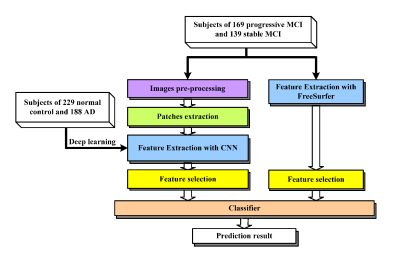3763
Deep Learning-based MRI Image Analysis for the Prediction of Conversion from Mild Cognitive Impairment to Alzheimer's Disease1College of Physics and Information Engineering, Fuzhou University, Fuzhou, China, 2School of Opto-Electronic and Communication Engineering, Xiamen University of Technology, Xiamen, China, 3School of Computer and Information Engineering, Xiamen University of Technology, Xiamen, China, 4Department of Radiology, Xiamen 2nd Hospital, Xiamen, Xiamen, China, 5Department of Electronic Science, Xiamen University, Xiamen, China
Synopsis
Accurate prediction of the conversion from mild cognitive impairment (MCI) to Alzheimer’s disease (AD) is critically important to slow down the progression to AD with early clinical trials. In this work, this prediction for 3 years is conducted on MRI images shared in Alzheimer’s Disease Neuroimaging Initiative (ADNI) dataset. Two powerful image analysis tools, including convolutional neural networks in deep learning and FreeSurfer in brain MRI analysis, are introduced to learn image features which are used for further classification. Cross validation results demonstrate that the proposed approach achieves more accurate and robust prediction comparing with the state-of-the-art grading biomarker method.
Purpose
The Alzheimer’s disease (AD) causes more than 60% of dementia cases [1] and is one of the most financially costly diseases in developed countries [2]. To slow down the progression to Alzheimer’s disease with early clinical trials, predicting conversion from mild cognitive impairment (MCI) to AD is critically important [3]. The purpose of this study is to predict subjects to be progressive MCI, who would convert to AD within three years, with a new approach to utilize powerful image analysis tools, including convolutional neural networks in deep learning [4] and FreeSurfer in brain MRI analysis [5].Method
The framework of the proposed approach is summarized in Fig.1.
The T1-weighted 1.5T MRI images of Alzheimer’s Disease Neuroimaging Initiative (ADNI), including 229 healthy normal controls subjects, 188 AD subjects, 169 progressive MCI subjects and 139 stable MCI subjects, are used to learn valuable features with convolutional neural networks and FreeSurfer. These features are further utilized to identify progressive MCI from stable MCI who would not convert into AD within three years.
In the part of deep learning with convolutional neural networks, sub-images of hippocampus are segmented from the preprocessed images and then patches are randomly extracted from these sub-images. Then, networks are trained on these patches from AD and normal control subjects. In the part of brain image analysis with FreeSurfer, quantitative indicators such as cortical volume, surface area and cortical thickness average are measured.
Finally, progressive and stable MCI are identified with classic classifiers.
Results
The proposed method is compared with the state-of-the-art grading biomarker method [6]. Leave-one-out cross validation is used to validate the performance following the evaluation process in [6].
Quantitative performance evaluation is summarized in Table 1. The accuracy, specificity, and area under the receiver operating characteristic curve of the proposed approach are greater than 80% and which is also higher than those of grading biomarker method. This implies that more accurate prediction is obtained by the new method. One limitation is that the specificity is lower than that of the grading biomarker method, indicating some progressive MCI are predicted incorrectly, which is expected to be improved in the future work.
Conclusion
The trained image features of hippocampus and quantitative indicators in
the brain MRI images have been shown to be promising to predict the conversion
from mild cognitive impairment to Alzheimer’s disease by using the the deep
learning tool, convolutional neural networks, and brain imaging expert tool, FreeSurfer.
Further improvement on the specificity will be developed.Acknowledgements
This work was partially supported by the National Key R&D Program of China (2017YFC0108703), Foundation of Educational and Scientific Research Projects for Young and Middle-aged Teachers of Fujian Province (JAT170406), National Natural Science Foundation of China (61571380 and 61302174), Natural Science Foundation of Fujian Province of China (2016J05205). The correspondence should be sent to Dr. Xiaobo Qu (Email: quxiaobo@xmu.edu.cn).
References
[1] J. T. Coyle, D. L. Price, and M. R. Delong, Alzheimer's disease: a disorder of cortical cholinergic innervation, Science, vol. 219, pp. 1184-1190, 1983.
[2] S. Bonin-Guillaume, D. Zekry, E. Giacobini, G. Gold, and J. Michel, The economical impact of dementia, Presse Medicale (Paris, France: 1983), vol. 34, pp. 35-41, 2005.
[3] K. G. Yiannopoulou and S. G. Papageorgiou, Current and future treatments for Alzheimer’s disease, Therapeutic advances in neurological disorders, vol. 6, pp. 19-33, 2013.
[4] Y. LeCun, Y. Bengio, and G. Hinton, Deep learning, Nature, vol. 521, pp. 436-444, 2015.
[5] FreeSurfer [Online]. Available: http://www.freesurfer.net/
[6] T. Tong, Q. Gao, R. Guerrero, C. Ledig, L. Chen, D. Rueckert, A Novel Grading Biomarker for the Prediction of Conversion From Mild Cognitive Impairment to Alzheimer's Disease, IEEE Transactions on Bio-Medical Engineering, vol. 64, pp. 155-165, 2017.

